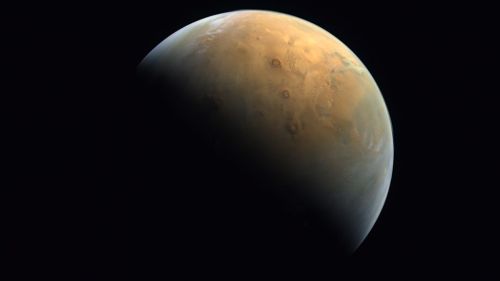
A gorgeous image of our planetary neighbor has been captured by the UAE’s Hope mission to Mars. Snapped from 15,500 miles away from the surface, the image shows some of Mars’s most recognizable features including Olympus Mons, the largest known volcano in the solar system.
The mission’s first image was posted on Twitter by the Crown Prince of UAE, Mohammed bin Zayed Al Nahyan. “The transmission of the Hope Probe’s first image of Mars is a defining moment in our history and marks the UAE joining advanced nations involved in space exploration,” he shared. “We hope this mission will lead to new discoveries about Mars which will benefit humanity.”
The Hope mission arrived at Mars this week, successfully entering orbit through a difficult braking maneuver. This was the first interplanetary mission by an Arab nation, and with its successful insertion into orbit, the UAE joined a small number of countries that have successfully sent a mission to Mars, including the U.S., the former Soviet Union, India, and Europe.
This list was joined by China later in the week as well, with the successful entering into orbit of the Tianwen-1 mission. NASA’s Perseverance rover is set to land on the red planet this coming week too.
The reason the three missions all launched and are arriving around the same time is due to them using a path between Earth and Mars called the Hohmann transfer orbit. This takes advantage of the point in time at which the two planets are closest together to plot the most efficient course to travel between them.
It’s impressive that both UAE and China succeeded in getting their craft into orbit successfully, as approximately half of all historic missions to Mars have failed due to the many challenges of controlling a spacecraft as it approaches another planet.
Now, the Hope mission can begin its scientific work, which includes studying the martian atmosphere to learn more about how the upper and low atmospheres interact through the planet’s different seasons. It will also investigate atmospheric escape — the phenomenon via which Mars is gradually losing its atmosphere.
Editors' Recommendations
- NASA selects 9 companies to work on low-cost Mars projects
- NASA needs a new approach for its challenging Mars Sample Return mission
- Stunning image shows the magnetic fields of our galaxy’s supermassive black hole
- See planets being born in new images from the Very Large Telescope
- It’s exactly 20 years since a Mars rover took this historic image